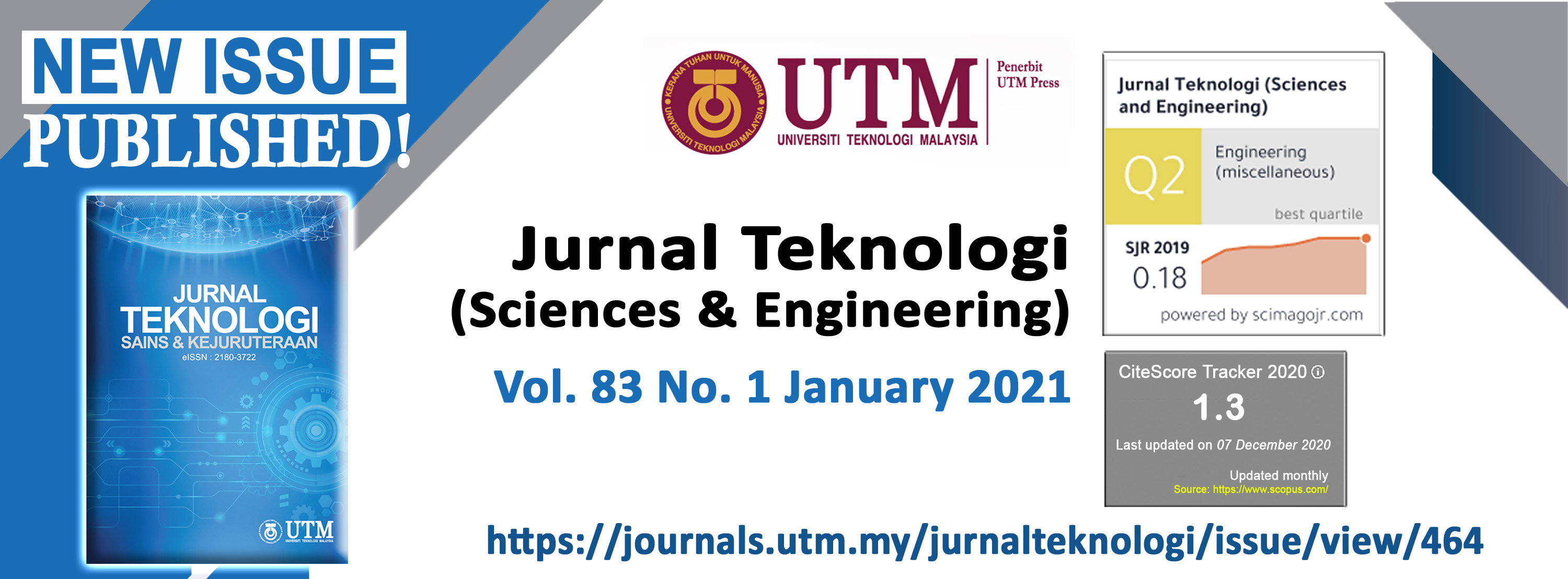FABRICATION AND CHARACTERISATION OF MG-ZN ALLOYS REINFORCED WITH CNF: A STUDY ON THE SINTERING PROCESS
DOI:
https://doi.org/10.11113/jurnalteknologi.v83.14768Keywords:
Magnesium, reinforcement, nanofibres, fabrication, composite, implantAbstract
Nowadays, magnesium (Mg) based alloys have gained much interest due to its potential use as biodegradable implants for the application of fixation, screws and plates in orthopaedics field. The main problems of biodegradable implants made from pure Mg are its low strength and easily corrodible. Therefore, the purpose of this study was to analyse the sintering temperature of magnesium-zinc (Mg-Zn) alloys reinforced with carbon nanofibres (CNF) through mechanical and morphological structures. Pure Mg, Zn, and CNF was prepared via powder metallurgy (PM) method. The samples were mechanically alloyed using planetary ball mill to create finer powder. Next, the samples were compacted using the Instron machine for 10 minutes at room temperature to produce a 10 mm diameter cylindrical platelet. Then, the specimens were heated with an argon gas flow for 4 hours at different sintering temperatures. The results showed that the optimum sintering temperature for Mg-Zn alloys reinforced with CNF was at 250℃ with elastic modulus and yield strength of 2729.886 MPa and 140.628 MPa, respectively. The findings of this study concluded that Mg-Zn alloys reinforced with CNF composites have great potential to be used as new biodegradable implants for medical applications in the future.
References
L. Berzina-Cimdina, M. Prakasam, J. Locs, A. Largeteau, D. Loca, and K. Salma-Ancane, “Biodegradable Materials and Metallic Implants—A Review,†J. Funct. Biomater., vol. 8, no. 4, p. 44, 2017.
V. K. Bommala, M. G. Krishna, and C. T. Rao, “Magnesium matrix composites for biomedical applications: A review,†J. Magnes. Alloy., pp. 1–8, 2018.
C. Godavitarne, A. Robertson, J. Peters, and B. Rogers, “Biodegradable materials,†Orthop. Trauma, vol. 31, no. 5, pp. 316–320, 2017.
E. Aghion, “Biodegradable metals,†Metals (Basel)., vol. 8, no. 10, pp. 1–34, 2018.
L. L. Soon, H. Zuhailawati, I. Suhaina, and B. K. Dhindaw, “Prediction of compressive strength of biodegradable Mg-Zn/HA composite via response surface methodology and its biodegradation,†Acta Metall. Sin. (English Lett., vol. 29, no. 5, pp. 464–474, 2016.
M. M. Yusof and H. Zuhailawati, “The effect of compaction pressure for on properties of binary and ternary magnesium alloys,†AIP Conf. Proc., vol. 1865, 2017.
Z. S. Seyedraoufi and S. Mirdamadi, “Synthesis , microstructure and mechanical properties of porous Mg – Zn scaffolds,†J. Mech. Behav. Biomed. Mater., vol. 21, pp. 1–8, 2013.
M. Hoon, J. Wei, and M. Gupta, “Interface tailoring to enhance mechanical properties of carbon nanotube reinforced magnesium composites,†J. Mater., vol. 60, pp. 490–495, 2014.
D. Annur, F. P. Lestari, A. Erryani, and I. Kartika, “Study of sintering on Mg-Zn-Ca alloy system,†AIP Conf. Proc., vol. 1964, no. May, 2018.
E. M. Salleh, H. Zuhailawati, and S. Ramakrishnan, “Synthesis of biodegradable Mg − Zn alloy by mechanical alloying : Statistical prediction of elastic modulus and mass loss using fractional factorial design,†Trans. Nonferrous Met. Soc. China, vol. 28, no. 4, pp. 687–699, 2018.
V. K. Bommala, M. G. Krishna, and C. T. Rao, “Magnesium matrix composites for biomedical applications: A review,†J. Magnes. Alloy., no. xxxx, pp. 1–8, 2018.
N. Saito et al., “Application of carbon fibers to biomaterials: A new era of nano-level control of carbon fibers after 30-years of development,†Chem. Soc. Rev., vol. 40, no. 7, pp. 3824–3834, 2011.
Y. Grossmann and D. Madjar, “Prosthetic treatment for severely misaligned implants: A clinical report,†J. Prosthet. Dent., vol. 88, no. 3, pp. 259–262, 2002.
Saba, N., Jawaid, M., & Sultan, M. T. H. (2019). An overview of mechanical and physical testing of composite materials. Mechanical and Physical Testing of Biocomposites, Fibre-Reinforced Composites and Hybrid Composites. Elsevier Ltd.
Huang, T., Zheng, Y., & Han, Y. (2016). Accelerating degradation rate of pure iron by zinc ion implantation. Regenerative Biomaterials, 3(4), 205–215.
Judson Durai, T., Sivapragash, M., & Edwin Sahayaraj, M. (2017). Effect of sintering temperature on mechanical properties of Mg-Zr alloy. International Journal of Mechanical and Production Engineering Research and Development, 7(5), 117–122.
Khan, W., Gopala, V., Challa, S., Langer, R., & Domb, A. J. (2014). Focal Controlled Drug Delivery, 3–32.
Kobayashi, S., & Kawai, W. (2007). Development of carbon nanofiber reinforced hydroxyapatite with enhanced mechanical properties. Composites Part A: Applied Science and Manufacturing, 38(1), 114–123.
Koç, E., Kannan, M. B., Ünal, M., & Candan, E. (2015). Influence of zinc on the microstructure, mechanical properties and in vitro corrosion behavior of magnesium e zinc binary alloys. Journal of Alloys and Compounds, 648, 291–296.
Li, G., Yang, H., Zheng, Y., Chen, X. H., Yang, J. A., Zhu, D., Takashima, K. (2019). Challenges in the use of zinc and its alloys as biodegradable metals: Perspective from biomechanical compatibility. Acta Biomaterialia, 97(5), 23-45.
Li, Q., Viereckl, A., Rottmair, C. A., & Singer, R. F. (2009). Improved processing of carbon nanotube/magnesium alloy composites. Composites Science and Technology, 69(7–8), 1193–1199.
Downloads
Published
Issue
Section
License
Copyright of articles that appear in Jurnal Teknologi belongs exclusively to Penerbit Universiti Teknologi Malaysia (Penerbit UTM Press). This copyright covers the rights to reproduce the article, including reprints, electronic reproductions, or any other reproductions of similar nature.
















